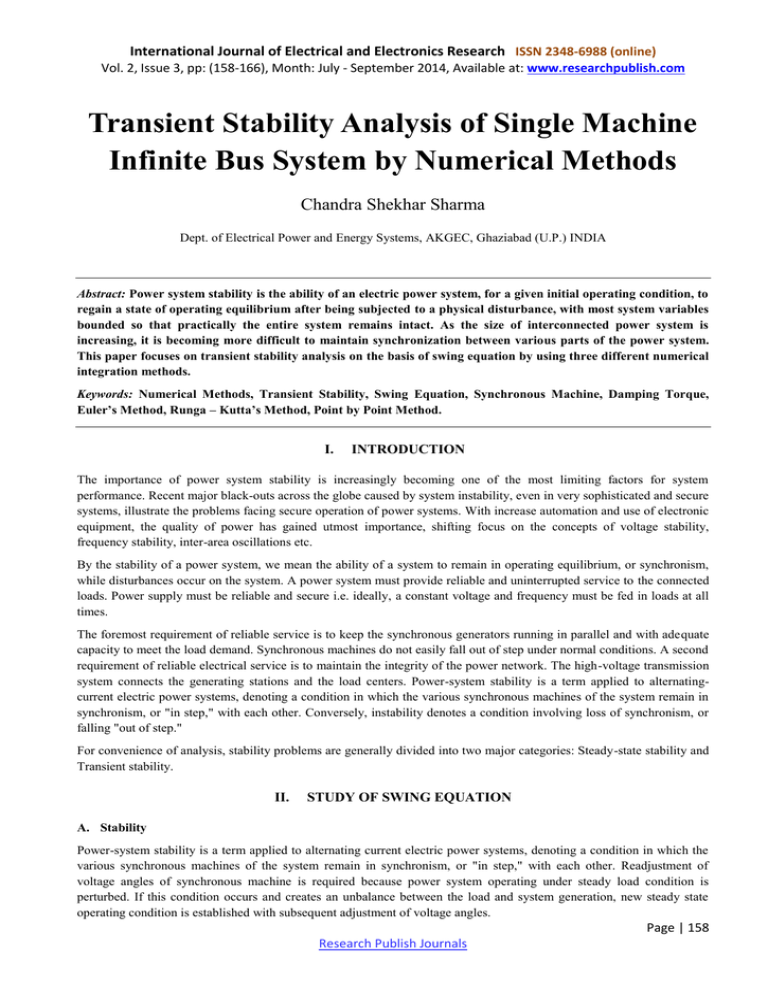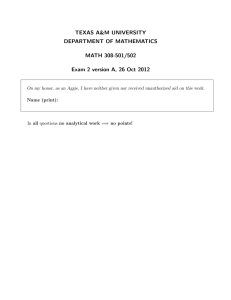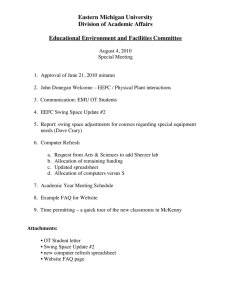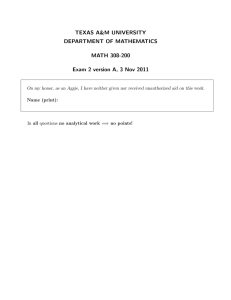Transient Stability Analysis by Numerical Methods
advertisement

International Journal of Electrical and Electronics Research ISSN 2348-6988 (online) Vol. 2, Issue 3, pp: (158-166), Month: July - September 2014, Available at: www.researchpublish.com Transient Stability Analysis of Single Machine Infinite Bus System by Numerical Methods Chandra Shekhar Sharma Dept. of Electrical Power and Energy Systems, AKGEC, Ghaziabad (U.P.) INDIA Abstract: Power system stability is the ability of an electric power system, for a given initial operating condition, to regain a state of operating equilibrium after being subjected to a physical disturbance, with most system variables bounded so that practically the entire system remains intact. As the size of interconnected power system is increasing, it is becoming more difficult to maintain synchronization between various parts of the power system. This paper focuses on transient stability analysis on the basis of swing equation by using three different numerical integration methods. Keywords: Numerical Methods, Transient Stability, Swing Equation, Synchronous Machine, Damping Torque, Euler’s Method, Runga – Kutta’s Method, Point by Point Method. I. INTRODUCTION The importance of power system stability is increasingly becoming one of the most limiting factors for system performance. Recent major black-outs across the globe caused by system instability, even in very sophisticated and secure systems, illustrate the problems facing secure operation of power systems. With increase automation and use of electronic equipment, the quality of power has gained utmost importance, shifting focus on the concepts of voltage stability, frequency stability, inter-area oscillations etc. By the stability of a power system, we mean the ability of a system to remain in operating equilibrium, or synchronism, while disturbances occur on the system. A power system must provide reliable and uninterrupted service to the connected loads. Power supply must be reliable and secure i.e. ideally, a constant voltage and frequency must be fed in loads at all times. The foremost requirement of reliable service is to keep the synchronous generators running in parallel and with adequate capacity to meet the load demand. Synchronous machines do not easily fall out of step under normal conditions. A second requirement of reliable electrical service is to maintain the integrity of the power network. The high-voltage transmission system connects the generating stations and the load centers. Power-system stability is a term applied to alternatingcurrent electric power systems, denoting a condition in which the various synchronous machines of the system remain in synchronism, or "in step," with each other. Conversely, instability denotes a condition involving loss of synchronism, or falling "out of step." For convenience of analysis, stability problems are generally divided into two major categories: Steady-state stability and Transient stability. II. STUDY OF SWING EQUATION A. Stability Power-system stability is a term applied to alternating current electric power systems, denoting a condition in which the various synchronous machines of the system remain in synchronism, or "in step," with each other. Readjustment of voltage angles of synchronous machine is required because power system operating under steady load condition is perturbed. If this condition occurs and creates an unbalance between the load and system generation, new steady state operating condition is established with subsequent adjustment of voltage angles. Page | 158 Research Publish Journals International Journal of Electrical and Electronics Research ISSN 2348-6988 (online) Vol. 2, Issue 3, pp: (158-166), Month: July - September 2014, Available at: www.researchpublish.com The perturbation may be in the form of major disturbance like: small load, random load changes under normal conditions, loss of generator, fault or loss of line or both. To establish the correct condition, fresh adjustment is needed with the new operating condition called transient period. The major criteria of stability is to maintain synchronism at the end of the transient period for the synchronous machines. For stability, the system oscillations must be damped, so that, the inherent forces in the system tends to reduce oscillations. After a disturbance, the stability problem is concerned with the behavior of synchronous machines. The stability problem can be categorized into steady state and transient state. B. Swing Equation The relative position of the resultant magnetic field axis and rotor axis is fixed under normal conditions. Power angle or torque angle is the angle between the two axes. During disturbance, a relative motion begins because of the deceleration or acceleration w.r.t the synchronously rotating air gap mmf. If, after this oscillatory period, the rotor locks back into synchronous speed, then, the generator will maintain its stability. If there is no net interchange of power then the rotor returns to its original position. Swing equation is the mathematical structure to describe relative motion. M Swing equation in terms of inertia constant M, d 2 m Pm Pe dt 2 Relationship between electrical power angle (δ) and mechanical power angle (δm), and electrical speed and mechanical speed of synchronous machine, where p is the pole number. p p m , m 2 2 Swing equation in terms of electrical power angle δ : 2 d 2 m M Pm P e p dt 2 Converting the swing equation into per unit system 2 H d 2 m Pm( pu ) Pe( pu ) s dt 2 Where M 2H , here H is inertia constant s III. STEADY STATE STABILTY Steady state stability refers to the ability of power system to maintain its synchronism and return to its original state when little disturbance occurs. It is not affected by any control efforts. Stability of a power system remains stable with conventional excitation and governor controls. A. Analysis of Steady-State Stability By Swing Equation Starting from swing equation: H d 2 Pm( pu ) Pe( pu ) Pm Pmax Sin( fo dt 2 Ps P max Cos Introduce a small disturbance Δδ Page | 159 Research Publish Journals International Journal of Electrical and Electronics Research ISSN 2348-6988 (online) Vol. 2, Issue 3, pp: (158-166), Month: July - September 2014, Available at: www.researchpublish.com Derivation is from δ=δ0+Δδ Simplify the nonlinear function of power angle δ Swing equation in terms of Δδ H d 2 Pm Cos 0 fo dt 2 B. DampingTorque Phenomena: When there is a difference in angular velocity between rotor and air gap field, an induction torque will be set up on rotor tending to minimize the difference of velocities. The damping power is approximately proportional to the speed deviation. Introduce a damping power by damping torque : Pd D d dt Introduce the damping power into swing equation. Characteristic equation is: H d 2 d D Ps fo dt 2 dt d 2 d 2n n 2 dt dt S 2 2nS n 0 D 2 f0 HPs 1, under normal operating conditions Where n is natural frequency of oscillation Roots of swing equation : 0 0 0 1 2 n 0 1 2 e nt sin(d t ) e nt sin d t Fig. 1 Diagram for Steady State Problem Page | 160 Research Publish Journals International Journal of Electrical and Electronics Research ISSN 2348-6988 (online) Vol. 2, Issue 3, pp: (158-166), Month: July - September 2014, Available at: www.researchpublish.com IV. TRANSIENT STABILTY Transient stability refers to the stability of a power system subject to a sudden and severe disturbance beyond the capability of the linear and continuous supplementary stability control, and the system may lose its stability at the first swing unless a more effective countermeasure is taken, usually of the discrete type, such as dynamic resistance braking or fast valving for the electric energy surplus area, or load shedding for the electric energy deficient area. For transient stability analysis and control design, the power system must be described by nonlinear differential equations. In most disturbances, oscillations are of such magnitude that linearization is not permissible and the nonlinear swing equation must be solved. A. Numerical Solution of Swing Equation The transient stability analysis requires the solution of a system of coupled non-linear differential equations. In general, no analytical solution of these equations exists. However, techniques are available to obtain an approximate solution of such differential equations by numerical methods and one must therefore resort to numerical computation techniques commonly known as digital simulation. Some of the commonly used numerical techniques for the solution of the swing equation are: Euler modified method Runga – Kutta method Point by point method The swing equation can be transformed into state variable form. And the two first order differential equations to be solved to obtain solution for the swing equation are: d dt d Pa Pm P max Sin D dt M M H Where M fo A. (a) Modified Euler’s method can be applied to above equations as explained below d d P i 1 ; where P i 1 i t dt Pi 1 dt i d d Pa ; where P i 1 = i + t dt Pi 1 M Pi 1 dt i Numerical errors are introduced because of discarding higher–order terms in Taylor’s expansion. Errors can be decreased by choosing smaller values of step size. If a step size is too small, it will increase computations, which can lead to large errors due to rounding off. The average value of the two derivatives is used to find the corrected values. d d dt i dt Pi Ci 1 = i + 2 t d d dt dt Pi i C i 1 i 2 t Page | 161 Research Publish Journals International Journal of Electrical and Electronics Research ISSN 2348-6988 (online) Vol. 2, Issue 3, pp: (158-166), Month: July - September 2014, Available at: www.researchpublish.com Fig. 2 Diagram for Transient State Stability design A. (b) Runga – Kutta’s Fourth order method can be applied to equations as explained below : Starting from initial value δ0, ω0, t0 and a step size of Δt, the formulae are as follows: K 1 t Pm P max Sin I1 t M K 2 t 2 K1 Pm P max Sin 2 t I2 M 2 K 3 t 2 K2 Pm P max Sin 2 t I3 M K 4 3 t Pm P max Sin K 3 I4 t M 1 K 1 2K 2 2K 3 K 4 6 1 I 1 2 I 2 2 I 3 I 4 6 δ1 and ω1 are used as initial values for the successive time step. A. (c ) Point By Point Method It is always required to know the critical clearing time corresponding to critical clearing angle so as to design the operating times of the relay and circuit breaker so that the time taken by them should be less than the critical clearing time for stable operation of the system. So the point-by-point method is used for the solution of critical clearing time associated with critical clearing angle and also for the solution of multi machine system. The step-by-step or point-by-point method is the conventional, approximate but proven method. This involves the calculation of the rotor angle as time is incremented. The accuracy of the solution depends upon the time increment used in the analysis. Page | 162 Research Publish Journals International Journal of Electrical and Electronics Research ISSN 2348-6988 (online) Vol. 2, Issue 3, pp: (158-166), Month: July - September 2014, Available at: www.researchpublish.com The following parameters are evaluated for each interval (n): The accelerating power, Pa (n-1) =Ps - Pe(n-1) From the swing equation, α(n-1)=Pa(n-1) / M 1 an 1t 2 1 3 n n an 1t 2 2 n 1 n n t 2 n 3 an 1 t 2 n 1 an 1 t 2 n 1 Pa(n 1) t 2 / M n n 1 n Fig. 3 Diagram for study of Point-by-Point Method V. SIMULATION For Steady State Response, a Synchronous generator is taken having a suitable inertia constant and transient reactance which is connected to an infinite bus through a purely reactive circuit where the reactances are marked on a common system base. The simulation is done through MATLAB 8.3(R2014a) Fig. 4 Rotor angle and Frequency vs Time Page | 163 Research Publish Journals International Journal of Electrical and Electronics Research ISSN 2348-6988 (online) Vol. 2, Issue 3, pp: (158-166), Month: July - September 2014, Available at: www.researchpublish.com For Transient State Response, a Synchronous generator is taken having a suitable inertia constant and transient reactance which is connected to an infinite bus through a purely reactive circuit where the reactances are marked on a common system base. The swing curve is used to determine the system stability and critical clearing time. The simulation is done through MATLAB 8.3(R2014a) and SIMULINK. Simulation was repeated for different numerical methods and swing curves were obtained. Fig. 5 Swing curve using Euler’s Method and Runga-Kutta’s Method respectively for fault cleared at 0.2s Fig. 6 Swing curve using Euler’s Method and Runga-Kutta’s Method respectively for fault cleared at 0.6s Page | 164 Research Publish Journals International Journal of Electrical and Electronics Research ISSN 2348-6988 (online) Vol. 2, Issue 3, pp: (158-166), Month: July - September 2014, Available at: www.researchpublish.com Fig. 7 Swing curve using Euler’s Method and Runga-Kutta’s Method respectively for fault cleared at 0.3s Simulation For Point by Point Method: The calculations for Point-by-point method have been programmed using MATLAB 8.3(R2014a) with a suitable Generator over a double circuit line to an infinite bus. A three phase circuit occurs at the midpoint of one of the transmission line. The fault is cleared by simultaneous opening of breakers. Fig. 8 Swing curve using Point-by-point Method for fault cleared at 0.225s and 0.6s respectively Page | 165 Research Publish Journals International Journal of Electrical and Electronics Research ISSN 2348-6988 (online) Vol. 2, Issue 3, pp: (158-166), Month: July - September 2014, Available at: www.researchpublish.com VI. CONCLUSION It can be seen that transient stability is greatly affected by the type, and location of a fault, so a power system analyst, must at the very outset of a stability study, decide on these two factors. For the case of one-machine system connected to infinite bus, it can be seen that an increase in the inertia constant M of the machine reduces the angle through which it swings in a given time interval offering a method of improving stability. But this can’t be employed in practice because of economic reasons and for the reason of slowing down of the response of the speed-governor loop apart from an excessive rotor weight. For a given clearing angle, as the maximum power limit of the various power angles is raised, it adds to the transient stability limit of the system. The maximum steady power of a system can be increased by raising the voltage profile of a system and by reducing the transfer reactance. While this approach is not suited for a detailed study of large systems, it is useful in gaining a physical insight into the effects of field circuit dynamics and in establishing the basis for methods of enhancing stability through excitation control. Machine Data: 1) For Steady State Response of Synchronous Generator: [ E = 1.50, V= 1.0; H= 7.94; X=0.60; Pm=0.8; D=0.138; f = 50; ] 2) For Transient State Response of Synchronous Generator: [ Pm = 0.80; E = 1.37; V = 1.0; X1 = 0.60; X2 = 1.75; X3 = 0.75; H = 4.0; f = 50; final time = 1; step size = 0.05; ] REFERENCES [1] IEEE/CIGRE Joint Task Force on Stability Terms and Definitions, Definition and Classification of Power System Stability”, IEEE Transactions on power systems, vol. 19, no. 2, May 2004. [2] Muyeen, S.M.; Ali, M.H.; Takahashi, R.; Murata, T.; Tamura, J.; Tomaki, Y.; Sakahara, A.; Sasano, E.; , "Comparative study on transient stability analysis of wind turbine generator system using different drive train models," Renewable Power Generation, IET , vol.1, no.2, pp.131-141, June 2007 [3] CIGRE Report: “Definitions of general terms relating to the stability of interconnected synchronous machine,” CIGRE, paper no. 334a, 1966. [4] CIGRE Task Force 38.01.07 on Power System Oscillations, “Analysis and control of power system oscillations,” CIGRE Technical Brochure, no. 111, Dec. 1996. [5] Marc Bodson, and Oleh Kiselychnyk “Nonlinear Dynamic Model and Stability Analysis of Self-Excited Induction Generators “2011 American Control Conference on O'Farrell Street, San Francisco, CA, USA June 29 July 01, 2011 [6] T. Ananthapadmanabha, A. D. Kulkarni, Manoj Kumar Pujar, H. Pradeep and S. Chetan “Rotor angle stability analysis of a distributed generator connected to distribution network “Journal of Electrical and Electronics Engineering Research Vol. 2(5), pp. 107- 113, November 2010. [7] Raj Kumar Jaganathan* and Tapan Kumar Saha “Voltage Stability analysis of grid connected embedded generators “ Australasian Universities Power Engineering Conference (AUPEC 2004) 26-29 September 2004, Brisbane, Australia. [8] P. Kundur, Power System Stability and Control. New York: McGraw- Hill, 1994. Page | 166 Research Publish Journals



